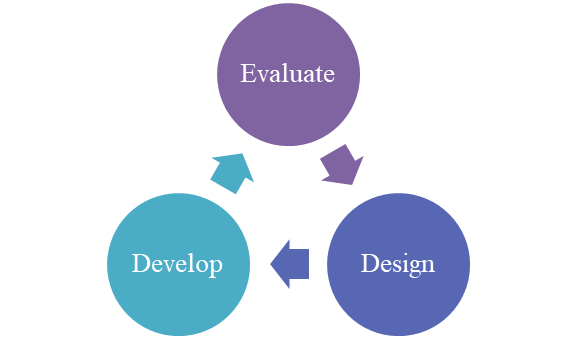Agile
Agile, another project management approach also adopted in instructional design, can be thought of as a modified, circular version of ADDIE. It originated with software developers, who need to continuously create and revise prototypes in order to refine a finished product. They sought an approach that was less time-consuming and expensive than ADDIE.
According to this iterative model, a learning activity or module (an “experience”) is formulated and produced in a continuous, circular process: evaluate, design, and develop. Note “the primary elements of an experience should be planned, visualized, and discussed before they are built.”*
*Alan Cooper, Robert Reimann, David Cronin, and Christopher Noessel, About Face: The Essentials of Interaction Design, 4th ed. (Indianapolis, IN: John Wiley & Sons, 2014), p. 158, original emphasis.
Below are overarching considerations and actions that may accompany the three process components.
- Evaluate: What do students need to do, know, and understand?
- Determine what students need to become competent in
- Identify how they will demonstrate, and be assessed on, their proficiency
- Design: What activities will meet these needs and help students achieve the above?
- Select the layout
- Organize the material
- Consider which content would benefit from interactivity
- Identify which features and functionality will be needed
- Select the technology or technologies that will be used
- Develop: How can the product be improved as it is built? (reiterative)
- Create the product
- Evaluate and adjust the product
- Implement and review the product
Occasionally, in special cases, we might repeat these phases with an author to build a prototype for a unique or unusual activity. Otherwise, the Agile model resonates more with the later stages of our publishing approach, as textbooks and Active Learning activities move into new editions with revisions and augmentations.



